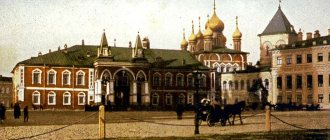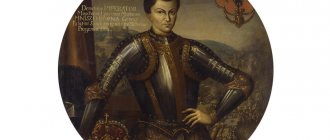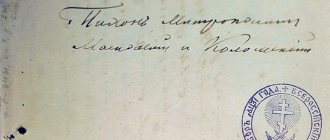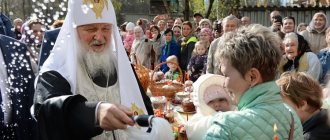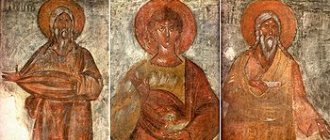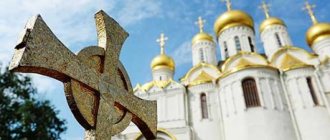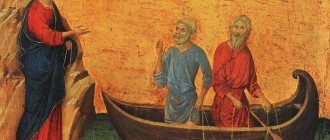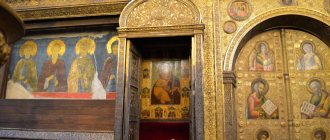| St. Peter, Metropolitan of Moscow |
Peter of Moscow
(+ 1326), Metropolitan of Kiev and All Russia, wonderworker, saint, the first of the Russian metropolitans to live in Moscow Memory: August 24 on the day of the transfer of relics, December 21 on the day of repose, in the Cathedrals of the Moscow Saints, as well as Volyn, Galicia, Kiev and Moscow saints
Born in Volyn in the second half of the 13th century. from the pious parents Theodore and Eupraxia. Even before the birth of her son, in a dream vision, the Lord revealed to Eupraxia the gracious pre-election of her son. They say that from an early age he was tongue-tied and very incomprehensible, but, thanks to the miraculous appearance of a certain holy man, Petrov’s lips were opened and his thoughts were illuminated with light. At the age of 12, young Peter entered the monastery. By that time, he had successfully studied book sciences and began to fulfill monastic obediences with particular zeal. The future saint devoted a lot of time to careful study of the Holy Scriptures and learned icon painting. The icons painted by the monk Peter were distributed to the brethren and Christians visiting the monastery (see also the Petrovskaya Icon of the Mother of God). For his virtuous ascetic life, the abbot of the monastery ordained the monk Peter to the rank of hieromonk.
After many years of exploits in the monastery, Hieromonk Peter, having asked for the blessing of the abbot, left the monastery in search of a secluded place. He set up a cell on the Rata River and began to labor in silence. Subsequently, a monastery called Novodvorsky was formed on the site of the exploits. For the visiting monks, a temple was built in the name of the Savior. Chosen as abbot, Saint Peter meekly instructed his spiritual children, never became angry with a guilty monk, and taught the brethren by word and example. The virtuous ascetic abbot became known far beyond the monastery. Prince Yuri Lvovich of Galicia often came to the monastery to hear the spiritual instructions of the holy ascetic.
Once the monastery was visited by Metropolitan Maxim, who was touring the Russian land with words of teaching and edification. Receiving the saint's blessing, Abbot Peter brought as a gift the image of the Dormition of the Most Holy Theotokos he had painted, before which Saint Maximus, until the end of his life, prayed for the salvation of the Russian land entrusted to him by God.
In 1299, Metropolitan Maxim finally left Kyiv and settled in Vladimir on the Klyazma. Dissatisfied with this, the Grand Duke of Galicia Yuri Lvovich wanted to have his own metropolitan. To this end, he chose Peter and sent him to Constantinople for initiation. But it was at this time - in 1305 - that Metropolitan Maxim died. Therefore, Patriarch Athanasius and the Council in June 1308 ordained Peter not as metropolitan of Galicia, but of all Russia.
At the same time, Saint Michael Yaroslavich of Tverskoy sent his associate and like-minded abbot Gerontius to the patriarch with a request to appoint him to the Russian metropolitanate. The Mother of God appeared to Gerontius, who was sailing the Black Sea at night, during a storm, and said: “You are working in vain, you will not receive the rank of hierarch. The one who wrote Me [1], Abbot of Ratsk Peter, will be elevated to the throne of the Russian Metropolis.” The words of the Mother of God were exactly fulfilled. When Saint Athanasius of Constantinople elevated Peter to the Russian metropolis, he gave him the holy vestments, staff and icon brought by Gerontius.
Upon his return to Russia in 1308, Metropolitan Peter stayed in Kyiv for a year, but the worries that threatened this city forced him, following the example of his predecessor, Maxim, to live in Vladimir on the Klyazma, where he moved in 1309.
At this time, there was a struggle for grand-ducal dignity between Mikhail Tverskoy and Yuri of Moscow. Metropolitan Peter took the side of the latter, as a result of which the Tverites accused him before the patriarch. For the trial of Saint Peter, a Council was convened in 1311 in Pereyaslavl, which acquitted him.
The High Hierarch experienced many difficulties in the first years of ruling the Russian Metropolis. In the Russian land, which suffered under the Tatar yoke, there was no firm order, and Saint Peter had to often change his places of residence. During this period, the saint’s labors and concerns for the establishment of true faith and morality in the state were especially important. During his constant tours of dioceses, he tirelessly taught the people and clergy about the strict preservation of Christian piety. He called on the warring princes to be peaceful and unity.
This meek archpastor knew how to be strict. He deprived Ismail of Sarsky of his episcopal rank, no doubt for an important crime against the Church or the Fatherland, and anathematized one dangerous heretic, Seit, whom he had accused of ungodly thinking, but who did not want to repent.
In 1313, when Uzbek became khan, the first of the khans to convert to Islam, St. Peter went to the Horde. He was received there with honor and released with a new label. All the previous benefits of the clergy were confirmed and a new one was added: all church people in all cases, not excluding criminal ones, were subject to the metropolitan court.
When, after the death of Mikhail Tverskoy and Yuri Moskovsky, Alexander Mikhailovich Tverskoy received from the khan a label for the great reign and entered into a fight with Ivan Danilovich (Kalita) Moskovsky, St. Peter took the side of the latter.
In 1325, Saint Peter, at the request of Grand Duke John Danilovich Kalita (1328 - 1340), transferred the metropolitan see from Vladimir to Moscow. This event was important for the entire Russian land. Saint Peter prophetically predicted liberation from the Tatar yoke and the future rise of Moscow as the center of all Russia.
At the request and advice of St. Petra led. book John Danilovich (Kalita) founded the first stone church in the name of the Dormition of the Blessed Virgin Mary on the square in Moscow in 1326, August 4th. “If you,” the saint said to the great prince, “calm my old age and build a temple of the Mother of God here, then you will be more glorious than all other princes, and your family will be magnified, my bones will remain in this city, the saints will want to live in it, and his hands will they will rise up on the shoulders of our enemies.” The holy metropolitan with his own hands built himself a stone tomb in the wall of this church and wanted to see the construction completed, but the Lord wanted the Church of the Assumption to be consecrated after the death of the saint.
On December 21, 1326, Saint Peter departed to God. The Holy Body of the High Hierarch was buried in the Assumption Cathedral in a stone coffin, which he himself prepared.
Many miracles happened through the prayers of the saint of God. Many healings were performed secretly, which testifies to the deep humility of the saint even after death. From the day of his repose, deep veneration for the High Hierarch of the Russian Church was established and spread throughout the Russian land. Saint Peter's protege, Saint Prokhor of Rostov, compiled a short life and canon for the late metropolitan, and already at the Vladimir Council in 1327 he advocated the canonization of Bishop Peter. In 1339, under Saint Theognostus, the glorification took place. At the tomb of the saint, the princes kissed the cross as a sign of fidelity to the Grand Duke of Moscow. As a particularly revered patron of Moscow, the saint was called as a witness when drawing up state treaties. The Novgorodians, who had the right to elect their rulers at St. Sophia, after joining Moscow under John III, swore an oath to install their archbishops only at the tomb of St. Peter the Wonderworker. At the tomb of the saint, the Russians were named and elected First Hierarch.
Russian chronicles constantly mention him; not a single significant government undertaking was complete without prayer at the tomb of St. Peter.
The first transfer of his relics was on July 1, 1472, and a celebration was established at the same time. The second transfer of the relics of St. Peter took place after the consecration of the newly built Assumption Cathedral, on August 24, 1479, and the celebration on July 1 was cancelled. The celebration of the manifestation of the relics of St. Peter (August 4) on the occasion of the appearance of the wife of Ivan the Terrible (1533-1584) Queen Anastasia (1547-1560) is also known. Saint Peter appeared to Queen Anastasia and did not allow anyone to open his coffin. He ordered the coffin to be sealed and a holiday established.
Troparion to Peter, Met. Moscow, All Russia Wonderworker
The formerly barren earth now rejoices: / behold, Christ is a lamp in you, / manifestly shining in the world, / and healing our ailments and illnesses. / For this reason, rejoice and rejoice with boldness: / for the saint is the Most High, / this is the one who has done.
Troparion Transfer of Relics
Today is the all-honorable holiday / of the presentation of your venerable relics, to Saint Peter, / greatly cheering your flock, / and your faithful fatherland, and people, / do not be destitute for them, praying to Christ God, / if the flock given by Him will be preserved from the enemy, / and save our souls.
On the way to asceticism
Saint Peter of Moscow was born into a pious family on the Volyn land. His father's name was Theodore, and his mother's name (according to some sources) was Eupraxia.
The parents learned from Revelation that the son would be chosen by the Omniscient God for a special service, that he would glorify Him and that he himself would be glorified even before his birth.
One day at dawn, the mother saw an extraordinary lamb in a dream (according to the plot of the vision, she carefully held it in her arms). Between the horns of the lamb grew a wonderful tree, replete with many fruits and flowers. Candles burned among the lush foliage. With all this, the tree exuded an indescribable fragrance. Waking up, Eupraxia could not explain to herself what this vision meant. And only later it became clear that the content of the dream pointed to the spiritual gifts of her son (who was then in his mother’s womb).
Until the age of seven, Peter was trained and raised in his parents' home. And then he was sent to study literacy and book sciences. He studied with diligence, but the teaching did not yield to him. This saddened the boy and upset his parents. But then, one day, a certain man in holy vestments appeared to him in a dream. A radiance poured out from him. At the word of the one who appeared, Peter opened his lips and he, blessing, poured sweetness into them. After this incident, Peter began to study more successfully and over time surpassed his peers.
Even in his youth, he preferred the difficult but faithful one - monasticism - to all possible paths of his life, and entered a monastery.
Historical significance of the reign of Ivan Kalita
Thanks to the efforts of Ivan Danilovich Kalita, the center of state and church power moved to Moscow. As the historical capital of the Russian land, this city was established forever. Ivan Kalita began to call himself the Grand Duke of All Rus'. He accepted this title by right. The Horde no longer entered his land. And Kalita humbled the appanage freemen of the Russian princes with an iron fist.
Military strength, diplomatic talent, and most importantly, a high level of state income, which Kalita never confused with personal income, allowed the prince to buy many near and far lands, villages, towns, and cities. There he settled boyars who were drawn to him from other princes.
Thanks to Kalita, the country lived without war for forty years. During these calm years, two whole generations managed to be born and grow up, to whom the impressions of childhood did not instill the unaccountable horror of their fathers and grandfathers before the Tatar. It was they who went to the Kulikovo field. Kalita was the first to begin to cultivate a new state - Muscovite Russia. That is why he is depicted on the icon of the Mother of God of Vladimir, planting the tree of the Russian State next to Metropolitan Peter.
Simon Ushakov.
Our Lady of Vladimir ( Tree of the Moscow State ). Icon from the Church of the Life-Giving Trinity in Nikitniki in Moscow. 1668
How was the potential accumulated by Ivan Kalita used?
Ivan Kalita was a rare politician who possessed strategic thinking, that is, he knew how to look several decades ahead and work for the future.
The goal of Ivan Danilovich Kalita’s life was the rise of Moscow, the construction of Moscow Rus', the Moscow Principality. Naturally, he thought about how to save his business. Feeling that his strength was leaving him, he decided in advance, during his lifetime, to transfer power to his eldest son Simeon the Proud (ruled from 1340 to 1353). To do this, he took Simeon to the Horde, introduced him to the khan, and guaranteed that Simeon would do everything the way he did. Khan approved the will of Ivan Kalita. After returning from the Horde, Ivan Kalita transferred actual power to Simeon, placing him in charge.
Simeon the Proud
Just before his death, Ivan Danilovich went to the Spassky Monastery of the Moscow Kremlin, where he received the great schema. This tradition was adopted by Ivan Kalita from his grandfather, Alexander Nevsky, who also accepted the great schema before his death. This was natural, because a person in power, making decisions about the death of people, participating in military campaigns, has many sins in life, despite all the good undertakings. Realizing that he will soon appear before the Lord, a person wants to be cleansed of the burden of sins. That is why, taking care of his soul, Ivan Kalita goes to a monastery and takes monastic vows.
Simeon the Proud adopted all the political traditions of his father. His policy repeated the policy of Ivan Kalita, combining caution and strength, the ability to take risks, but to take risks wisely. Simeon the Proud was a great ruler. Under him, Moscow became very strong.
But in 1353 there was a terrible plague epidemic. Entire cities died out from this “Black Death.” During the epidemic, Simeon and his entire family fell ill and died. Quite unexpectedly for contemporaries, power passed to the middle son of Ivan Kalita, Ivan the Red. Ivan the Red was not ready to rule either by character or by preparation. Nevertheless, he found himself at the head of the Moscow principality and ruled it from 1353 to 1359. And the principality begins to disintegrate, feuds begin between the boyars, and the weakening of the authority of Moscow begins. In 1359, when Ivan the Red also died suddenly, Moscow was in a very difficult situation. And here the Church played a huge role. The fact that Ivan Danilovich made the Church an ally of Moscow helped a lot. At this time, Metropolitan Alexy took the entire political life of Moscow on his shoulders.
Thus, Ivan Kalita created foreign economic conditions favorable for the development of the Moscow state; pursued an internal policy of pacification and restoration of order; gave the basis to Saint Peter to decide that it was Moscow that should become the spiritual center of Rus', from where the unification of Russian lands would come. He was one of the rare political figures who had strategic thinking, who knew how to look several decades ahead and work for the future.
Monastic path
While asceticizing in the monastery, he humbly and zealously fulfilled the obediences assigned to him, spent a lot of time praying and reading the Word of God, and studied icon painting. Subsequently, he mastered this Christian art and became a true master. The images created by his work were distributed among the monastery brethren and pilgrim visitors.
Step by step Peter grew in spiritual age. Seeing in the monk a model of morality, purity and ability for pastoral work, the abbot of the monastery ordained him as a hierodeacon, and then as a hieromonk.
Carrying out this responsible service, Father Peter, with his characteristic sincerity, sought to bring more benefit to the brethren entrusted to his care, but over time, following the example of many great ascetics, he began to seek solitude in order to completely devote himself to deep Christian prayer and contemplation.
Having received a blessing in this regard from the abbot, Father Peter, leaving the monastery, went in search of a suitable deserted place. Having found it with the help of God near the Rata River, he mortgaged and built himself a modest, small cell. Here he spent many days and nights in communication with God.
Saint Peter, Metropolitan of Kiev and All Rus', Moscow Wonderworker
Monastery » Saints » St. Peter, Metropolitan of Kiev, Moscow and All Russia
Saint Peter was born on the Galicia-Volyn land in the second half of the 13th century into a family of pious Christians Feodor and Eupraxia, who probably belonged to the boyar class.
At the age of seven, Peter was sent to learn to read and write at a monastery school. He studied diligently, but at first he was not able to read and write. The youth prayed to God to give him the gift of understanding the Scriptures. And one day in a dream a man appeared to Peter in a holy robe, who said to him: “Open your mouth, child.” When Peter did this, the saint touched his tongue with his hand, and Saint Peter felt that his throat was filled with something sweet. And from that time on, the blessed youth discovered such talents that he was soon ahead of all his peers.
At the age of twelve, Peter retired to a monastery, where he carried out obedience; After the required years had passed, for a virtuous life and zealous fulfillment of the entrusted obedience, the abbot of the monastery decided to ordain the monk Peter to the rank of hieromonk. While asceticizing in the monastery, he humbly and zealously fulfilled the obediences assigned to him, spent a lot of time praying and reading the Word of God, and studied icon painting. Subsequently, he mastered this art and became a true master. The images he created were distributed among the brethren of the monastery and pilgrims. After many years of labors in the monastery, Hieromonk Peter asks the abbot of the monastery for a blessing to leave the monastery in order to retire to a secluded place to continue his monastic feat. On the banks of the Rata River he set up a small cell for himself. And soon the place of the secret feat of the future metropolitan became a monastery, where he was elected abbot. The ascetic abbot became known far beyond the monastery. Prince Yuri Lvovich of Galicia often came to the monastery to hear the spiritual instructions of the holy ascetic.
As abbot, he painted an icon of the Mother of God that was unlike any other; later it was named after the author - Petrovskaya.
Once the monastery was visited by Metropolitan Maxim of Kiev, who was touring the Russian land with words of teaching and edification. Receiving the saint's blessing, Abbot Peter brought as a gift to the archpastor an image of the Most Holy Theotokos he had painted, before which Saint Maximus, until the end of his life, prayed for the salvation of the Russian land entrusted to him by God.
When Metropolitan Maxim died, the throne of Russian metropolitans was unoccupied for some time. The Grand Duke of Vladimir, Saint Michael of Tver, sent Abbot Gerontius to the Patriarch of Constantinople with a request to appoint him to the Russian Metropolis. Gerontius took with him the image of the Mother of God, which was in the possession of Metropolitan Maxim.
At the same time, Prince Yuri of Galicia sent Abbot Peter to Constantinople, wanting the Patriarch to appoint him Metropolitan of Galicia. The Mother of God appeared to Gerontius, who was sailing the Black Sea at night, during a storm, and said: “You are working in vain, you will not receive the rank of hierarch. The one who wrote Me, Abbot Peter of Ratsk, will be elevated to the throne of the Russian Metropolis.” The words of the Mother of God were exactly fulfilled: Patriarch Athanasius of Constantinople with the Council of Bishops elevated St. Peter to the Russian Metropolis, handing over to him the holy vestments, staff and icon brought by Gerontius. Upon his return to Russia in 1308, Metropolitan Peter stayed in Kyiv for a year and then moved to Vladimir.
The High Hierarch experienced many difficulties in the first years of ruling the Russian Metropolis. In the Russian land, which suffered under the Tatar yoke, there was no firm order, and Saint Peter had to often change his places of residence. Grand Duke Mikhail of Tverskoy, upset that it was not his man who became the Russian Metropolitan, was never able to receive Saint Peter, so the Metropolitan could not stay in Vladimir for a long time. During his constant tours of dioceses, he tirelessly taught the people and clergy about the strict preservation of Christian piety. He called on the warring princes to be peaceful and unity.
However, Bishop Andrei of Tver brought charges against the saint before the Patriarch. For the trial of Metropolitan Peter in 1311, a council was convened in Pereyaslavl, which was attended by the envoy of the Patriarch, the clergy, princes and boyars. Saint Peter was especially zealously defended by representatives of Moscow, among whom was the young prince Ivan Danilovich. The accusations against Metropolitan Peter were recognized as slander. Saint Peter turned to Bishop Andrew with the words: “Peace be with you, child of Christ! It was not you, but the primordial envier of the human race - the devil - who aroused this war. Be careful in future that the worst does not happen to you. God will forgive the past.”
In 1313, when Uzbek, the first of the khans to convert to Islam, became the khan of the Golden Horde, Saint Peter went to the Horde to confirm his powers. He was received there with honor and released with a new label. The previous benefits of the clergy were confirmed and a new one was added: all church people in all cases, not excluding criminal ones, were subject to the metropolitan court.
Traveling throughout Rus', Saint Peter increasingly visits Moscow. Seven hundred years ago Moscow was still a small city within the modern Kremlin, but even then it was quite noisy and crowded. The saint needed a place for solitary prayer. Such a place turned out to be the elevated bank of the Neglinnaya River, not far from the Kremlin, where the small village of Vysokoye was located among the forests. This place reminded Metropolitan Peter of the monastery on the banks of the Rata River, where he had previously been abbot; This is where the monastery was built. In it, Metropolitan Peter erected a wooden church in the name of the holy supreme apostles Peter - his heavenly patron - and Paul, which is why the monastery was originally called Peter and Paul Monastery (this name for the monastery was found in documents even more than three hundred years after the reconsecration of its main temple in honor of St. Peter himself) . This is how the history of the Vysoko-Petrovsky Monastery began.
Here, praying for the fate of Rus', Metropolitan Peter became more and more convinced of the idea of transferring the metropolitan see to Moscow. In 1325 the saint finally moved to this city. The prince built a “vast courtyard” for Metropolitan Peter in the eastern part of the Kremlin. However, the saint still loved to stay at the small monastery he founded. A road was built from the monastery to the Kremlin in the forest, which to this day is called Petrovka.
Saint Peter predicted liberation from the Tatar yoke and the future rise of Moscow as the center of all Russia.
At the request and advice of Saint Peter, Grand Duke Ivan Danilovich Kalita founded the first stone church in Moscow in 1326 in honor of the Dormition of the Blessed Virgin Mary. “If you listen to me, my son,” the saint said to the Grand Duke, “you will erect the temple of the Most Holy Theotokos in your city, and you yourself will become famous more than other princes, and your sons and grandchildren throughout generations and generations, and this city will be famous throughout all Rus'.” , and the saints will live in him, and he will defeat his enemies, and God will be glorified in him. My bones will also be placed in it.” Construction began on August 4. The holy metropolitan, with his own hands, built himself a stone coffin in the altar of this church, near the altar, and wanted to see the construction completed, but the Church of the Assumption was consecrated after his death, in 1327, on August 14 - on the eve of the patronal feast.
The move of Saint Peter to Moscow, the construction on his advice of the Assumption Cathedral in the Kremlin, which became not only the tomb of the Primate of the Russian Orthodox Church, but also the main cathedral of Rus', which was being revived after the Tatar invasion, contributed, as the saint predicted, to the unification of Russian lands around Moscow. Thanks to the fact that Saint Peter made Moscow the place of his primal labors and his resting place, it became the spiritual center of Rus' and in the future the Russian capital.
At the relics of St. Peter in the Assumption Cathedral in Moscow. Photo: S. Vlasov
From the words of His Holiness Patriarch Kirill of Moscow and All Rus' after the service in the Vysoko-Petrovsky Monastery on September 6, 2014: “And then something very symbolic happens, which ultimately predetermined the rise of Moscow as the city of the Grand Duke, although at that time it was not one... When Saint Peter was buried at the northern wall of the Assumption Cathedral under construction, it became clear that Moscow was becoming the Mother See. And after Saint Peter, all the Kyiv metropolitans of that time - the Primates of the Russian Orthodox Church - chose Moscow as their place of residence. And therefore, by right, we call them all Metropolitans of Kyiv, Moscow and All Rus'." According to legend, an angel announced the day of death to the Metropolitan and Peter, "full of spiritual joy, performed the Divine Liturgy that day, offered prayers for Prince John, for all Christians Russian land, his flock, and remembered the departed. Arriving from the temple, the saint called the church clergy and gave him the last instruction. Then calling the poor, the wretched and his servants, he distributed abundant alms to them. Saint Peter distributed the rest of his property for his commemoration among clergy and monks, and allocated a significant part for the construction of the Church of the Dormition of the Blessed Virgin Mary.”
Prince Ivan Danilovich was away then, and Saint Peter turned to his nobleman Protasius with the words: “My son, here I am leaving this life. I leave mercy, peace and blessings from God to my beloved son, Prince John, and to his seed forever. For the fact that my son calmed me down, may the Lord God reward him a hundredfold in this world, may he inherit eternal life, may the succession of possessing his place not be taken away from his family, and may his memory spread.”
As evening approached, the saint began to perform Vespers. During prayer, he turned to Archimandrite Theodore: “Peace be with you, my son, I am dying.”
On December 21 (Old Art.), 1326, Saint Peter departed to God. His holy body was buried in a stone tomb prepared by him himself in the Assumption Cathedral.
During the solemn transfer of the relics to the temple, looking at the numerous clergy, prince, nobles, and townspeople accompanying this procession, an unknown infidel reproachfully expressed doubts about the need to give such honors to a dead person. And as soon as he expressed this, he saw Saint Peter sitting on his bed, blessing the people on both sides of him. At the same time, three sick people received healing from the relics of the saint.
A few days after the burial of the saint, miracles of healing began to take place at his tomb. Thus, a young man who had been unable to use his hands since the day of his birth was cured. Soon here, through prayer, hearing returned to the deaf, sight to the blind, and a miracle happened to the hunchback, who received “stretching” (straightening) from the metropolitan’s tomb. Many other miracles happened to those who came to Metropolitan Peter with prayer. Prince Ivan Danilovich Kalita ordered a description of the saint’s miracles to be compiled, which was publicly read by Bishop Prokhor of Rostov in Vladimir from the church pulpit during a cathedral service on the holiday. At this time, a non-believer testified to the vision that he had during the burial of the saint. The first Metropolitan of Moscow was locally canonized a year after his repose. This was an event of extreme spiritual significance for the Moscow princes and the entire state.
Many miracles happened through the prayers of the saint of God. From the day of his repose, deep veneration for the High Hierarch of the Russian Church was established and spread throughout the Russian land. Thirteen years later, in 1339, under Saint Theognostus, he was canonized by the Council in Constantinople. Thus, Saint Peter became the first canonized Moscow saint. At the tomb of the saint, the princes kissed the cross as a sign of fidelity to the Grand Duke of Moscow. As a particularly revered patron of Moscow, the saint was called as a witness when drawing up state treaties. The Novgorodians, who had the right to elect their rulers at St. Sophia, after joining Moscow under John III, swore an oath to install their archbishops only at the tomb of St. Peter the Wonderworker. At the tomb of the saint, Russian High Hierarchs were named and elected.
Russian chronicles constantly mention Metropolitan Peter; not a single significant state undertaking was complete without prayer at the tomb of St. Peter. In 1472 and 1479 the relics of St. Peter were transferred. In memory of these events, celebrations were established on October 5 (18) and August 24 (September 6).
- 170shares
- 166
- 0
- 2
- 2
- Share
Education of the monastery
When rumors about the exploits of the holy hermit spread throughout the surrounding area, believers began to flock to him, seeking spiritual nourishment. Over time, a monastery was formed on that very spot.
The brethren elected Father Peter as abbot of the monastery. It is known that in this responsible position he showed himself not only as a loving shepherd, instructing by word and personal example, but also as an excellent organizer.
The glory of the new monastery grew day by day. Many people, even eminent ones, even Prince Galitsky Yuri Lvovich, came there, wanting to listen to the abbot’s instructions and ask for his pastoral blessing and heartfelt prayers.
Once, the monastery was visited by Metropolitan Maxim of Vladimir, who was making a tour of Russian lands. Father Peter, having received the saint's blessing, humbly presented him with a gift of the icon of the Dormition of the Blessed Virgin Mary, made with his own hand. According to legend, Vladyka Maxim prayed in front of this image until the end of his earthly life.
Activities of Saint Peter as Metropolitan
By the end of the thirteenth century, the robbery and violence committed by the Tatar conquerors reached such a scale that people began to flee Kyiv en masse. In 1299, Metropolitan Maxim, guided by considerations of church economy, moved from Kyiv to Vladimir.
Prince Galitsky did not approve of this step. He wanted the Metropolitan to be closer to him. For this purpose, he decided to appoint Abbot Peter to the metropolitan see, and sent him to Constantinople. At this time, Metropolitan Maxim reposed.
Mikhail Tverskoy, who then occupied the grand-ducal throne, guided by his own interests, tried to appoint Abbot Gerontius to the metropolitan see, for which he also sent him to the Patriarch of Constantinople. At the same time, Gerontius did not fail to take with him the holy staff, utensils, and even an icon painted and presented to the Metropolitan by Peter.
Of the two candidates, God Himself chose the worthy one. When Gerontius was sailing on a ship along the Black Sea, at night, during a storm, the Heavenly Queen appeared to him and unambiguously announced that the metropolitan throne would go to the Ratsky abbot. And so it happened: Patriarch Athanasius of Constantinople installed Peter as Metropolitan, and elevated him to the dignity of Metropolitan of All Rus'.
Returning to his homeland in 1308, the saint lived in Kyiv for about a year, after which he moved to Vladimir: where his predecessor established the department of Metropolitan of All Rus'.
Times were difficult. On the one hand, there are disagreements and discord between the princes. On the other hand - the Tatar yoke. Some northern rulers expressed extreme dissatisfaction with the installation of Peter on the see, disturbing and outraged the people.
Saint Peter often changed places of residence. People needed consolation, encouragement, and pacification, but most of all they had to take care of preserving, spreading and strengthening the true faith.
At some point, a confrontation arose between Yuri of Moscow and Mikhail Tverskoy: both wanted to see themselves on the grand-ducal throne. It was hardly possible for Metropolitan Peter to completely distance himself from this struggle, because it concerned not only the two arguing princely persons, but also their subjects, Orthodox people.
The saint considered it right to take Yuri’s side, which, of course, caused the discontent of Mikhail Tverskoy and his entourage. In response to the choice of Metropolitan Peter, they drew up an accusation against him and brought it to the ears of the Patriarch. He was in no hurry to trust the accusations and decided to thoroughly investigate the case. Convened on this occasion in 1311, the Council in Pereyaslavl acquitted the Russian saint.
In 1312 or 1313, Metropolitan Peter, out of church and state necessity, made a trip to the Horde, where he met with Khan Uzbek, received from him a letter confirming previous benefits for the clergy and giving the metropolitan the right to judge church people.
After the death of princes Mikhail and Yuri, the khan's label for the great reign was given to Mikhail's son, Alexander Tverskoy, who, taking advantage of the situation, entered into a struggle for power and influence with Ivan Kalita (Moscow). This time, Metropolitan Peter again inclined his favor to the side of Moscow.
The Golden Horde in Rus' at the beginning of the reign of Ivan Kalita
By the beginning of the 14th century, the place of Rus' on the political map of the world was confidently taken by the Golden Horde. It stretches from the lower Danube in the west to the Ob in the east. In Asia, it extended from Tashkent in the south to Tyumen in the north. In Europe, in addition to Rus', the lands between the Volga and the Urals, the North Caucasus, Crimea and the Black Sea steppes came under the rule of the Horde. The capital of the Golden Horde was initially Sarai, founded in the lower reaches of the Volga in the 1250s, and later Sarai al-Jedid, located on the left bank of the Akhtuba just south of present-day Volgograd.
Map of the Golden Horde during the time of Ivan Kalita
There were many ancient cities on the lands of the Golden Horde, but few of them managed to maintain their significance after the Mongol devastation. Ryazan perished, about two hundred houses remained from Kyiv. However, the trading cities of northwestern Russia - Polotsk, Smolensk and Novgorod - still connected Northern Europe with the Horde and the East. Even in the northern, eastern and southern parts of Rus', where the main blow of the Mongol hordes fell, many cities were revived within a few years. The Mongols needed cities as centers of craft and trade, from which tribute could be regularly collected. As a rule, they did not destroy them if the inhabitants agreed to surrender. New cities were built in the Horde itself. These cities became Mongol administrative centers. The Mongols usually turned captives into slaves. Some were sold through the Crimean ports to the East and even to Western Europe, others had to work for their masters in the Horde.
At the end of the 13th century, the position of the Russian people in the Golden Horde began to improve little by little. By this time, the struggle for power had begun, and the opposing parties in the Horde sought to win over the Russian princes, providing them with all sorts of concessions and interfering less and less in the internal life of the Russian principalities. In the next century, the history of Rus' and the Golden Horde became closely intertwined. The princes either participated in the feuds of the Mongol Khans and nobles, or, trying to at least slightly expand the boundaries of their principalities, they themselves brought Mongol troops to Rus' or denounced each other to the khan and his entourage. In turn, the Mongols supported conflicts between Russian princes, eliminated those who were not pleasing, and arranged marriages of Russian princes and daughters of Mongol nobles.
Ivan Kalita and the reason for his political success
What is the reason for the political success of Ivan Kalita?
Ivan Kalita. Painting of the Chamber of Facets
Firstly, Ivan Danilovich paid tribute to the Horde on time. Collecting tribute was a very difficult task. Per capita income was approximately one and a half rubles per year. And the tribute amounted to from half to one and a half rubles a year. This was a lot of money, on which you could live for a whole year. Paying tribute was very difficult. And yet, Ivan Kalita managed not only to pay tribute to the Horde, but also to let his subjects live. The Russian land grew richer.
Secondly, Ivan Kalita maintained good relations with the Horde, which was also difficult. At this time, changes were also taking place in the Horde. It was under Khan Uzbek, during whose reign Ivan Danilovich Kalita ruled, that the Horde converted to Islam. During the time of the pagan Horde there were no religious problems. They did not interfere in religious affairs. The main thing for the pagan Horde was that the Horde khans be glorified in Russian churches. With the adoption of the militant religion of Islam, religious problems also arose. In those days, Islam was enforced by force of arms.
The wisdom of the Moscow princes Daniil of Moscow and Ivan Kalita, the heirs of Alexander Nevsky, was that they continued the policy of Alexander Nevsky: to negotiate with the Horde; bring a lot of money there; give bribes; crawl on your knees if necessary, as long as there are no raids, as long as the Horde don’t invade Russian soil. And at the same time, a tough policy was pursued on the western borders of Rus'. Here issues were resolved both diplomatically and militarily, in which Ivan Danilovich was also an amazing master.
Through the efforts of Ivan Kalita, the Principality of Moscow managed to avoid ruin. How did Ivan Danilovich manage to maintain that “great silence” for which the chroniclers praise him? In the chronicle there is a famous phrase that Ivan Danilovich came to reign and “then there was a great silence on the Russian land, and the filthy ones stopped fighting the Russian land and freed the Orthodox from the languor of the Basurmen.” Ivan Kalita and his sons Simeon the Proud and Ivan the Red provided the Moscow principality with forty years of peace, from 1328 to 1368. In 1368, a great war began with Lithuania.
All the princes had troubles primarily due to the fact that they could not pay tribute on time. They began to organize adventures that failed. As a result, punitive detachments from the Horde arrived, and tribute was collected through robbery. And Ivan Danilovich always found money to settle accounts with the Horde. In addition, trips to the Horde required money for offerings and gifts to all the khan's relatives and influential persons. A trip to the Horde was a serious and expensive undertaking, before which each time they wrote a will, because they did not know whether they would return from there alive. Ivan Danilovich traveled to the Horde regularly and knew the Tatar language.
Where did Ivan Kalita get the funds?
Firstly, having become the Grand Duke, he brought order to the collection of tribute in the lands under his control. Large amounts of money were simply stolen. Local boyars and princes collected money for the Horde and kept it in their pockets. Ivan, with a firm hand, “cleared the Russian land from robbers and thieves,” as the chronicles say. He carried out executions on defaulters. So, in the Rostov land, he ordered a local boyar to be hung by his feet and held there until his relatives paid the debt. And the money was immediately found.
Secondly, due to robberies on the roads, trade stopped. He caught all the robbers.
Thirdly, Ivan Kalita began to penetrate the Russian north. The north was famous for its furs, which were called soft gold. Fur has been a currency at all times. Novgorod ruled there, living on the northern fur trade. But Ivan Danilovich managed to break into this market. He sent his artels to the north, which were engaged in the procurement of furs, and also caught falcons, gyrfalcon-hunting birds, which were also highly valued, especially in the Horde.
Fourthly, Ivan Danilovich was a master at inventing new taxes, as well as collecting taxes.
Fifthly, he began producing intoxicating drinks. In Moscow, under him, they began to produce “intoxicated honey” - “mead”. Under Ivan Kalita, “mead” was supplied to the countries of Eastern Europe and the Golden Horde, which brought in a good income.
Transfer of the center of activity to Moscow
In 1325, guided by his own considerations and the recommendation of the Grand Duke, Ivan Kalita, the saint located the metropolitan see in Moscow.
A few months later, Metropolitan Peter expressed to the Grand Duke his desire to build a stone church in Moscow dedicated to the Dormition of the Mother of God. Knowing from the Revelation of God that death was approaching, the saint built a place for his burial in the wall of this temple.
Before his death, he gave a kind word to his flock, taught peace to everyone, said a blessing to the prince (who was not in the city at that moment), said goodbye in a Christian way and rested in the Lord with prayer on his lips. This happened on December 21, 1326.
The saint's body was placed on a bed with great honor and taken to the place that he had prepared for himself.
Subsequently, many miracles were performed with the relics. According to chroniclers, the Grand Duke ordered the collection and recording of information about miraculous events occurring through prayers addressed to St. Peter.
As an edifying manual, the Instructions for Abbots, Priests and Deacons have come down to us from him.
Temple in honor of the saint
Among the most famous buildings of this saint is the Church of Peter the Metropolitan of Moscow in St. Petersburg. It’s not difficult to find it at the intersection of Romenskaya and Dnepropetrovskaya streets. It belongs to the St. Petersburg Diocese of the Russian Orthodox Church. It was built in 1911-1912 on the territory of the Holy Trinity Tvorozhkovsky Convent.
For a long time after the revolutions, the monastery was buried, and all valuables were removed from it. Then the buildings were transferred to the plant, and the structures were dismantled, the buildings were rebuilt, and the interior was destroyed. And only in 1994 it was returned to the complex of the diocese's courtyard. Since then, reconstruction work has been underway there to return it to its previous condition. Thanks to the donations of caring people and parishioners, the goal is gradually being achieved. You can find more information about it online on the parish website.
Troparion to Saint Peter, Metropolitan of Moscow, tone 4
Today has come the all-honorable holiday / of the presentation of your honorable relics, to Saint Peter, / greatly cheering your flock, / and your faithful fatherland, and people, / do not be destitute for them, praying to Christ God, / that the flock bestowed by Him may be preserved from the enemies of the enemy // and save our souls.
Troparion to Saint Peter, Metropolitan of Moscow, Wonderworker of All Russia, tone 4
Having lived faithfully in the world, / having been enlightened by a pure life, / he was accepted by the flock through the teachings of the priesthood, / he was an heir to the apostle. / Therefore, accept the gift of miracles from God, Father Peter, / pray to Christ God, // that he may save our souls.
What do they pray to the Metropolitan of Moscow for?
There is a lot of information that when asking before the icon of St. Peter, Metropolitan of Moscow, even the most daring requests can be accomplished. Those who expressed their requests noted special assistance in solving health problems. But besides this, you can ask him about:
- getting rid of troubles and illnesses;
- solving everyday problem situations;
- finding a way out in difficult situations and choices, etc.
Saying prayers in front of his holy face can relieve not only physical discomfort from an illness, but also improve your mental state in many ways and gain balance.
